20+ SAMPLE Affidavit of Occupancy
-

Affidavit of Occupancy Template
download now -

Family Affidavit of Occupancy Total
download now -

Basic Affidavit of Occupancy
download now -

Affidavit in Lieu of Certificate of Occupancy
download now -

Affidavit of Occupancy Example
download now -

Affidavit of Multiple Occupancy
download now -

Affidavit of Occupancy For Rental Registration Exemption
download now -

Affidavit of Safe Occupancy
download now -

Affidavit of Occupancy Accessory Apartment
download now -

Affidavit of Home-Owner Occupancy
download now -

Affidavit of Dwelling Unit Occupancy
download now -

Printable Affidavit of Occupancy
download now -
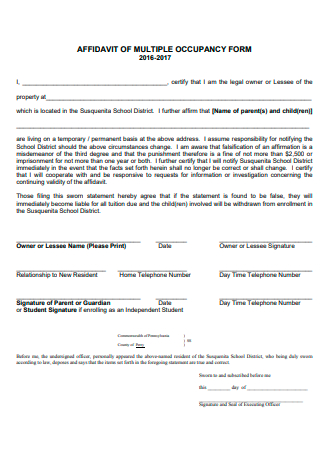
Affidavit of Multiple Occupancy Form
download now -
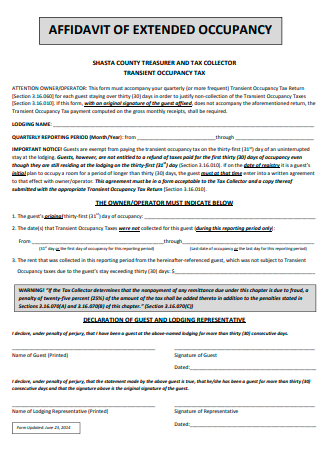
Affidavit of Extended Occupancy
download now -

Affidavit of Occupancy and Financial Status
download now -

Affidavit of Owner Occupancy
download now -
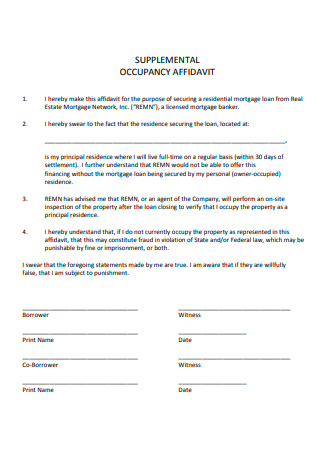
Affidavit of Supplemental Occupancy
download now -
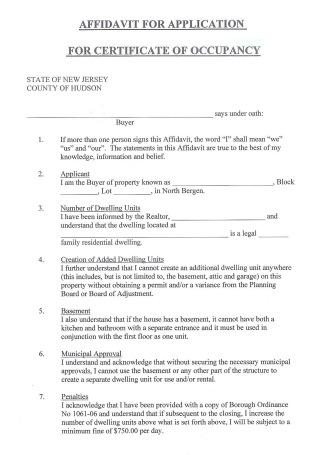
Affidavit For Application For Certificate of Occupancy
download now -

Affidavit of Non-Occupancy
download now -
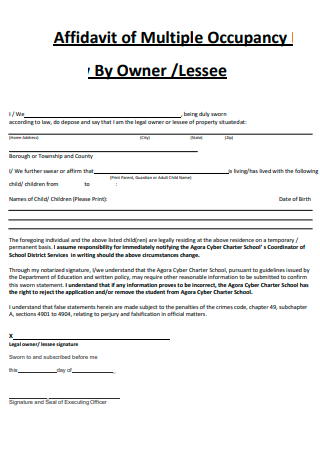
Affidavit of Multiple Occupancy By Owner
download now -

Affidavit of Occupancy in PDF
download now
FREE Affidavit of Occupancy s to Download
20+ SAMPLE Affidavit of Occupancy
What Is Affidavit of Occupancy?
What Is the Importance of Affidavit of Occupancy?
What Does Occupancy Mean for a Home Loan?
What Are the Benefits of an Affidavit of Occupancy?
What Is a Certificate of Occupancy?
Six Steps to Implementing Occupancy Assurance:
FAQs
How Is Occupancy Calculated?
What Is Occupancy Load?
Why Do Lenders Require Occupancy Agreements?
What If the Buyer Does Not Honor the Occupancy Affidavit?
What Is Affidavit of Occupancy?
An Occupancy Affidavit is a document that is used to confirm a property being financed will serve as a homeowner’s principal residence. The Occupancy Affidavit is a written promise from the homeowner that they intend to occupy the property. The affidavit of occupancy goes by other names: Statement of occupancy, Occupancy statement, Occupancy certification, Owner occupancy letter, and Residency affidavit.
In a nutshell, the document confirms that a financed property will serve as a homeowner’s principal residence. The purchaser signs the affidavit promising to occupy the property. The lender gets the primary benefit of the document because a residence occupied by the owner is more likely to be well-maintained and retain its value. In return for the reduced risk, the lender knocks a few percentage points off the loan.
What Is the Importance of Affidavit of Occupancy?
The importance of an affidavit of occupancy is to describe the class of property, serve as proof that the property meets all compliance standards and regulations, and meets building codes. Property classes include residential, retail, commercial, industrial, and mixed-use. By classifying a property, the affidavit prevents the property from being used in a way that was not intended. The affidavit shows the property is fit for occupancy by a residential, commercial, or retail tenant. If a tenant tries to complain about violations at the property, the affidavit of occupancy can be used to determine whether the complaint has merit.
To start with, a certificate of occupancy is a legal requirement for many property transactions. For instance, if you have renovated a house, you won’t be legally allowed to sell it without first obtaining a certificate of occupancy. The legal consequences can be particularly severe if you are building new construction, and you could potentially be fined for every day the property is in use without a valid certificate.
But beyond the legal requirements, there are other good reasons to get a certificate of occupancy. Most importantly, it guarantees that your building is safe—or at least safe enough to pass a detailed inspection. So, even if you are not legally required to obtain a certificate in a given situation, it might be a good idea. It will give peace of mind to potential buyers, and potentially increase your sale price.
What Does Occupancy Mean for a Home Loan?
Different types of properties have different definitions of occupancy.
A primary residence typically requires the owner to occupy the residence for a majority of the year, generally six months or more. The owner may not rent the residence to a tenant when not living there.
A vacation home or second home is defined as an additional property occupied by the owner for a smaller portion of the year. Most are 50 miles or more away from the primary residence, and may not be rented out to tenants while the owner is not living there.
Whereas, property used as a rental, whether a single, multi-family, multiple-unit, or condominium home, is considered an investment property. The owner acts as a landlord and may or may not live on the property.
Anytime property changes hands, the mortgage lender likely requires one, whether it’s new construction, property conversion or renovation, a change in ownership, or major construction. The document is available through the local government, typically a town or county department of housing or building department.
The affidavit must be requested before any work is performed. The certificate itself won’t be issued until the work is complete, and the property has passed all inspection requirements, including plumbing, electrical, fire safety, and general building. If any fines are due, they must be paid as well before the affidavit is provided.
What Are the Benefits of an Affidavit of Occupancy?
Mortgage originators and brokers’ organizations use an affidavit of occupancy as protection against mortgage fraud. The certificate provides the lender with a transparent chain of evidence to use to expose and prosecute fraud.
The affidavit also brings order to the real estate market by holding small real estate investors accountable for their decisions. It reduces the risk faced by the mortgage lender and may reduce the incidence of non-performing loans on rental properties.
With the affidavit in hand guaranteeing the use of the property, the lender tends to offer lower interest rates for homeowners who purchase a primary residence. As mentioned above, the property is maintained better, with less risk to its resale value.
The best course of action to take when starting to compose your affidavit for proof of residence letter is to determine what information is being asked of you. It is good practice to take a personalized approach when writing this type of letter whenever possible, simply answering the questions asked of you.
If that is not possible, such as when the request comes from your tenant who isn’t sure of the exact information the recipient needs, you can take a general approach by providing information the recipient would likely want to have. If you do not know what information to include, you can feel safe by incorporating the following:
A statement that your tenant resides in your rental property and the address
The term of the lease: the date your tenant moved in and the date the lease terminates
- Who else is on the lease
- Who else lives on the premises
- How much rent your tenant pays
What Is a Certificate of Occupancy?
A certificate of occupancy is an official government document that certifies that a building is safe for occupancy. It will include the owner’s name, the street address, and additional information about the property. This information includes:
When Do You Need a Certificate of Occupancy:
Certificates of occupancy do not need to be issued for every minor change to a property. For instance, no certificate will be required if you are painting the walls or replacing the bathroom fixtures. That said, there are certain circumstances where you will need to have one issued. These include:
New construction. When a building is first constructed, it will need to have a certificate of occupancy before it can be sold from the developer to the buyer.
You have performed a major renovation. A certificate of occupancy is typically required when you build an addition onto your house. Typically, you would need to get a building permit ahead of time, and a certificate of occupancy when the work is complete. If you are rehabbing a condemned property, a certificate of occupancy will always be required. Without this certificate, you won’t be able to sell the property.
The property is changing hands. This will differ from municipality to municipality. In some cases, there is no need to have a certificate re-issued when the property changes hands. In other cases, it is necessary for all property sales. In some, a certificate of occupancy must even be issued when a rental property has a change in tenancy.
The property type has changed. Different types of property have different code and permitting requirements. For example, single-family homes, multi-family homes, and duplexes may all have different standards. If you’ve taken a single-family home and modified it into a five-unit apartment building, you will need to obtain a new certificate of occupancy. The same goes for changing zoning types, such as repurposing a commercial building for industrial use. You’ll also need a new certificate if you are changing property classes. So, even if you are converting from one type of commercial use to another, you might still need a certificate of occupancy to reflect those changes.
Six Steps to Implementing Occupancy Assurance:
Achieving occupancy assurance in an open environment requires careful planning and analysis. Normally, there are six steps involved in the development process.
Step 1: Access Analysis
In this important first step, the planning team studies the flow of personnel and vehicles into the operating environment. The objective is to define the rhythm and pulse of the operations. Access for the perimeter of the overall property should be studied, including the building perimeters, floor levels, and on a room-by-room basis. Factors such as departments’ access level, access groupings, time of day/night and seasonal fluctuations should be analyzed. This is achieved by reviewing access records, interviewing personnel, and conducting observational studies. The result is the documentation of the current flow of vehicles and personnel throughout the operating environment.
Step 2: Existing Security Program Study
This step involves the analysis of existing security programs including access control systems, CCTV camera systems, physical security barriers, security personnel deployment, security policies and procedures, emergency response capabilities, security command systems, and end-user adherence to security protocols.
Step 3: Occupancy Assurance Plan Development
With an understanding of the personnel flow and the existing security program, the team can prepare the Occupancy Assurance Plan. The plan allows for more effective and efficient monitoring and control of access and egress in order to achieve the appropriate level of access assurance for the given operating environment. Open environments such as exterior areas, cafeterias, classrooms and lobbies may be monitored with a combination of police or security personnel and properly deployed CCTV cameras. Closed environments such as graduate student laboratories may have multiple layers of security such as security check points, CCTV cameras, security personnel, and access control systems limiting access to authorized personnel only.
Step 4: Implementation Planning
Achieving occupancy assurance can be expensive and time-consuming. Therefore, it is typically best to have a multiyear implementation master plan. Early phases of the plan can focus on achieving occupancy assurance at building perimeters and the highest-volume access and egress points. Solutions typically include a combination of signage, door configuration, door hardware, access control readers, CCTV cameras, policies and procedures, security system programming, security personnel deployment, and other countermeasures as appropriate. In later phases of the plan, occupancy assurance can be achieved at deeper levels of the facilities and may include the implementation of a security operations center.
Step 5: Procurement, Procedure Development and Training
To make sure systems are properly deployed, a detailed technical specification should accompany the master plan. This should include typical designs for CCTV cameras, access control systems, networking, door types, turnstiles, programming schedules and wiring requirements. Procedures for security personnel and end users should also be developed. These procedures should be communicated as early as possible to end users. It is important to explain that the enhancements are being made for safety and security purposes. Privacy statements and CCTV camera image and access data policies should also be developed. Some organizations have gone so far as to limit CCTV and access control data to criminal investigations only, deciding not to utilize this data for reviews of workplace performance such as tardiness, excessive breaks, etc.
Step 6: Building Occupancy Assurance Testing
The security systems, processes and procedures deployed to achieve occupancy assurance should be tested to ensure that the desired outcomes are being achieved. Additionally, testing should continue to be done periodically, as occupancy requirements and access flow can change, threats are constantly evolving and security systems are continuously being enhanced.
FAQs
How Is Occupancy Calculated?
It is calculated by dividing the total number of rooms occupied by the total number of rooms available times 100. Your property occupancy rate is one of the most important indicators of success.
What Is Occupancy Load?
It is the total number of people that might occupy a building or space at any one time. The occupant load reflects the maximum number of people anticipated to occupy the building rooms or spaces at any given time and under all possible situations.
Why Do Lenders Require Occupancy Agreements?
If the Lender is going to be giving the Buyer a personal residence loan package, they want an assurance that they will in fact be living there. The necessity of the occupancy agreement is due to the difference between loan packages for personal residences and investment properties. Residential loan packages come with lower interest rates while investment loan packages have higher interest rates, due to higher risk factors with investment properties that will be rented out.
What If the Buyer Does Not Honor the Occupancy Affidavit?
Since the Affidavit is signed under oath and notarized, and since its terms are clear or “unambiguous,” it will be fairly easy for the Lender to enforce their rights in court. Failure to honor an occupancy affidavit is considered mortgage fraud. The most likely result is that the Lender, upon discovering a misrepresentation, can immediately call the entire outstanding amount of the mortgage note. There may also be additional civil and criminal penalties.
An affidavit of occupancy is a legal document that, once signed, becomes a sworn statement. Mortgage lenders prefer an affidavit of occupancy and reward signers with lower interest rates. The affidavit also shows the property classification (residential, retail, industrial, or commercial), and serves as proof of use. In addition, an affidavit also guarantees the property has passed all inspections and complies with standards and codes. Not all affidavits require notarization, but whether notarized or not, they are still legally binding on the signer. Anyone who does not obey the affidavit can be penalized financially or imprisoned for mortgage fraud.
So, the next time you purchase property, pay close attention to any document labeled affidavit of occupancy or one of its aliases. Once you sign it, you are bound to use the property as specified in the certification.
